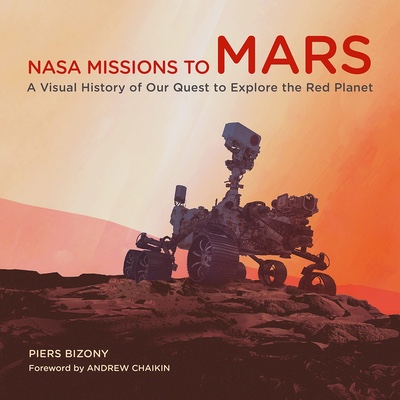Review: NASA Missions to Marsby Jeff Foust
|
| Chaikin cites a comment Wernher von Braun made in 1954, when he predicted it might be a century or more before humans set foot on Mars. “I hope it turns out it he was just a bit too conservative, because I want to live to see it.” |
A new book illustrates that long-running interest in Mars exploration. NASA Missions to Mars is primarily a picture book about past, ongoing, and proposed missions to Mars. Prolific author Piers Bizony compiled dozens of images from Mars missions, along with illustrations of proposed missions and other concepts, to provide a high-level overview of the interest in exploring the Red Planet.
Bizony, in the book’s preface, calls NASA Missions to Mars “a family-friendly, nonacademic, almost purely visual celebration” of the past and future of Mars exploration. That is an accurate assessment. There’s only a few pages of text for each chapter, setting the stage for the images that follow. Most of that information, as well as the images, will be familiar to those with at least a passing knowledge of Mars exploration.
The book is, though, a good overview of Mars exploration for those unfamiliar with it, from Mars in early science-fiction works through the decades of robotic missions to proposals for sending humans to the planet. Most of those images, from Viking to Perseverance, are well known, but there are some hidden gems, like old illustrations from decades ago of concepts for humans missions to Mars.
Andrew Chaikin contributes an introductory essay in the book, talking about his childhood interest in Mars. He planned to pursue a career in planetary geology, seeing it as a steppingstone to becoming an astronaut, and was even an intern on the Viking science team while in college. His career took a different turn, but he crossed paths with Mars time and time again as a science writer. As for humans on Mars, “I have my doubts” about proposals for sending humans to Mars in the 2030s, a notional goal NASA leaders have offered. He cites a comment Wernher von Braun made in 1954, when he predicted it might be a century or more before humans set foot on Mars. “I hope it turns out it he was just a bit too conservative, because I want to live to see it.”
Bizony, in the preface, offers similar thoughts, lamenting the delays in sending humans to Mars throughout his adult life. But, he adds, “I am very much still alive and so is the dream of reaching Mars.” It’s just that some people are getting a bit impatient.
Note: we are using a new commenting system, which may require you to create a new account.
